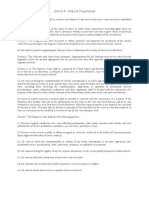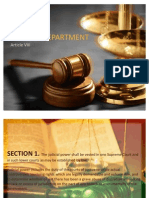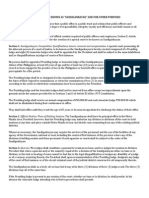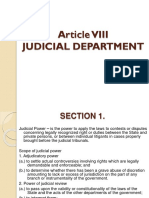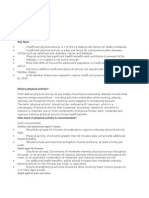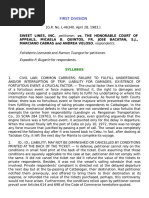0 ratings0% found this document useful (0 votes)
Art 8
Art 8
Uploaded by
Angelica Cassandra VillenaThe document discusses the independence and structure of the Philippine judiciary. It outlines that the Supreme Court is the only constitutional court and has administrative supervision over lower courts. It also discusses the appointment and qualifications of judges, the jurisdiction and powers of courts, and the requirement for courts to decide cases within specific time periods.
Copyright:
© All Rights Reserved
Available Formats
Download as PPTX, PDF, TXT or read online from Scribd
Download as pptx, pdf, or txt
Art 8
Art 8
Uploaded by
Angelica Cassandra Villena0 ratings0% found this document useful (0 votes)
The document discusses the independence and structure of the Philippine judiciary. It outlines that the Supreme Court is the only constitutional court and has administrative supervision over lower courts. It also discusses the appointment and qualifications of judges, the jurisdiction and powers of courts, and the requirement for courts to decide cases within specific time periods.
Original Description:
phil consti
Original Title
art 8
Copyright
© © All Rights Reserved
Available Formats
PPTX, PDF, TXT or read online from Scribd
Share this document
Did you find this document useful?
Is this content inappropriate?
The document discusses the independence and structure of the Philippine judiciary. It outlines that the Supreme Court is the only constitutional court and has administrative supervision over lower courts. It also discusses the appointment and qualifications of judges, the jurisdiction and powers of courts, and the requirement for courts to decide cases within specific time periods.
Copyright:
© All Rights Reserved
Available Formats
Download as PPTX, PDF, TXT or read online from Scribd
Download as pptx, pdf, or txt
0 ratings0% found this document useful (0 votes)
Art 8
Art 8
Uploaded by
Angelica Cassandra VillenaThe document discusses the independence and structure of the Philippine judiciary. It outlines that the Supreme Court is the only constitutional court and has administrative supervision over lower courts. It also discusses the appointment and qualifications of judges, the jurisdiction and powers of courts, and the requirement for courts to decide cases within specific time periods.
Copyright:
© All Rights Reserved
Available Formats
Download as PPTX, PDF, TXT or read online from Scribd
Download as pptx, pdf, or txt
You are on page 1/ 27
It is trite to say that courts of justice are the bastion of
the rights and liberties of the people.
THE JUDICIAL DEPARTMENT
- The Supreme Court is a constitutional body. It cannot be
abolished nor may its membership or the manner of its meetings
be changed by mere legislation.
- The members of the Supreme Court may not be removed except
in impeachment.
- Appointees to the Judiciary are now nominated by the Judicial
and Bar Council and no longer subject to confirmation by the
Commission on Appointments.
INDEPENDENCE OF THE JUDICIARY
- The Supreme Court now has administrative supervision over
all lower courts and their personnel.
- The Supreme Court has exclusive power to discipline judges of
lower courts.
- They shall not be designated to any agency performing quasi-
judicial or administrative functions.
INDEPENDENCE OF THE JUDICIARY
- The salaries of judges may not be reduced during their
continuance in office.
- The judiciary shall enjoy fiscal autonomy.
- The Supreme Court may initiate rules on court.
- The Supreme Court can appoint all officials and employees of
the judiciary.
INDEPENDENCE OF THE JUDICIARY
The judicial power shall be vested not only in the Supreme Court
but in such lower courts as may be established by law.
The Supreme Court is the only constitutional court, all the lower
courts being of statutory creation.
JUDICIAL POWER
The different lower courts under the Judiciary Reorganization
Law are the Court of Appeals, the regional trial courts, the
metropolitan trial courts, the municipal trial courts, and the
municipal circuit trial courts.
Not included in the reorganization were the Court of Tax
Appeals although it is also a court of justice and the special
statutory court known as the Sandiganbayan, as well as the Sharia
courts for the Muslims.
JUDICIAL POWER
Judicial Power, to settle actual controversies involving rights which
are legally demandable and enforceable but also, to determine
whether or not there has been grave abuse of discretion
amounting to lack or excess of jurisdiction on the part of any
branch or instrumentality of the government.
The power of the courts, ultimately the Supreme Court, TO
INTERPRET the constitution, and TO TEST THE
VALIDITY of executive and legislative acts in the light of
their conformity with the fundamental law.
JUDICIAL POWER
Jurisdiction is defined as the authority by which courts
take cognizance of and decide cases, the legal right by which
judges exercise their authority. Jurisdiction over cases. No law
may be passed depriving it of the power to review a life sentence,
for example, as this comes under its minimum appellate
jurisdiction, which may not be reduced.
JURISDICTION
To de-politicize our courts of justices, ensure the choice
of competent judges, and fill existing vacancies as soon as
possible so as not to unduly disrupt judicial proceedings.
They shall be appointed by the President from a list of at
least three nominees prepared by the Judicial and Bar Council for
every vacancy. The appointments need no confirmation.
APPOINTMENTS
Natural-born citizen of the Philippines
At least forty years of age
Must have been for fifteen years or more a judge of a lower court
or engaged in the practice of law in the Philippines
QUALIFICATION
Composed of the Chief Justice as ex officio Chairman,
the Secretary of Justice, and a representative of the Congress as
ex officio Members, a representative of the Integrated Bar, a
professor of law, a retired Member of the Supreme Court, and a
representative of the private sector.
JUDICIAL AND BAR COUNCIL
The Supreme Court shall be composed of a Chief Justice
and fourteen Associate Justices.
It may sit en banc or in its discretion, in divisions of three, five,
or seven Members. Any vacancy shall be filled within ninety days
from the occurrence thereof.
COMPOSITION OF THE SUPREME
COURT
In order that a constitutional issue may properly be the subject of
judicial review, all the following four elements must concur :
There must be an actual case or controversy;
The issue must be raised by the proper party;
It must be raised at the earliest opportunity; and
There must be a necessity of deciding the constitutional question.
REQUISITES OF JUDICIAL REVIEW
CHECKING (Declaring unconstitutional the Act of Congress, president )
LEGITIMAZING (Upholding the constitutionality of an act of the president )
SYMBOLIC (When the court formulate guiding constitutional principles, precepts,
doctrines or rules)
FUNCTIONS JUDICIAL REVIEW
An unconstitutional act is not a law; it confers no rights;
it imposes no duties; it affords no protection; it creates no office;
it is, in legal contemplation, inoperative, as if it had not been
passed. It never existed at all.
EFFECTS OF A DECLARATION
OF UNCONSTITUTIONALITY
Original Jurisdiction
Under international law, diplomats, and even consuls to a
lesser extent, are not subject to the jurisdiction of the courts of
the receiving State, save in certain cases, as when immunity is
waived either expressly or impliedly.
POWERS OF THE SUPREME
COURT
JUDICIAL DEPARTMENT
ARTICLE VIII
The Members of the Supreme Court and judges of the lower
courts shall be appointed by the President from a list of at least
three nominees prepared by the Judicial and Bar Council for
every vacancy. Such appointments need no confirmation.
For the lower courts, the President shall issue the appointments
within ninety days from the submission of the list.
SECTION 9
The salary of the Chief Justice and of the Associate Justices of
the Supreme Court, and of judges of lower courts, shall be fixed
by law. During their continuance in office, their salary shall not be
decreased.
SECTION 10
The Members of the Supreme Court and judges of lower courts
shall hold office during good behavior until they reach the age of
seventy years or become incapacitated to discharge the duties of
their office. The Supreme Court en banc shall have the power to
discipline judges of lower courts, or order their dismissal by a
vote of a majority of the Members who actually took part in the
deliberations on the issues in the case and voted.
SECTION 11
The Members of the Supreme Court and of other courts
established by law shall not be designated to any agency
performing quasi-judicial or administrative functions.cralaw
SECTION 12
The conclusions of the Supreme Court in any case submitted to
it for decision en banc or in division shall be reached in
consultation before the case is assigned to a Member for the
writing of the opinion of the Court. A certification to this effect
signed by the Chief Justice shall be issued and a copy thereof
attached to the record of the case and served upon the parties.
Any Members who took no part, or dissented, or abstained from
a decision or resolution, must state the reason therefor. The same
requirements shall be observed by all lower collegiate
courts.cralaw
SECTION 13
No decision shall be rendered by any court without expressing
therein clearly and distinctly the facts and the law on which it is
based.cralaw No petition for review or motion for
reconsideration of a decision of the court shall be refused due
course or denied without stating the legal basis therefor.cralaw
SECTION 14
(1) All cases or matters filed after the effectivity of this
Constitution must be decided or resolved within twenty-four
months from date of submission for the Supreme Court, and,
unless reduced by the Supreme Court, twelve months for all lower
collegiate courts, and three months for all other lower courts.
(2) A case or matter shall be deemed submitted for decision or
resolution upon the filing of the last pleading, brief, or
memorandum required by the Rules of Court or by the court
itself.
SECTION 15
(3) Upon the expiration of the corresponding period, a
certification to this effect signed by the Chief Justice or the
presiding judge shall forthwith be issued and a copy thereof
attached to the record of the case or matter, and served upon the
parties. The certification shall state why a decision or resolution
has not been rendered or issued within said period.
SECTION 15
(4) Despite the expiration of the applicable mandatory period,
the court, without prejudice to such responsibility as may have
been incurred in consequence thereof, shall decide or resolve the
case or matter submitted thereto for determination, without
further delay.
SECTION 15
The Supreme Court shall, within thirty days from the opening of
each regular session of the Congress, submit to the President and
the Congress an annual report on the operations and activities of
the Judiciary.
SECTION 16
You might also like
- Law Society England and Wales Jurisdiction of Choice100% (1)Law Society England and Wales Jurisdiction of Choice32 pages
- Court The 3 Pillar: by Faculty, Bscrim, Mscrim, Phdcrim Angeles University Foundation100% (5)Court The 3 Pillar: by Faculty, Bscrim, Mscrim, Phdcrim Angeles University Foundation48 pages
- Article Viii Judicial Department: CorpusNo ratings yetArticle Viii Judicial Department: Corpus10 pages
- Judicialdepartment 110813081109 Phpapp02No ratings yetJudicialdepartment 110813081109 Phpapp0226 pages
- Presidential Decree No. 1606, S. 1978 - Official Gazette of The Republic of The PhilippinesNo ratings yetPresidential Decree No. 1606, S. 1978 - Official Gazette of The Republic of The Philippines5 pages
- Accountability of Public Officers CasesNo ratings yetAccountability of Public Officers Cases116 pages
- PRESIDENTIAL DECREE No. 1606 December 10, 1978 Revising Presidential Decree No. 1486 Creating A Special Court To Be Known As "Sandiganbayan" and For Other PurposesNo ratings yetPRESIDENTIAL DECREE No. 1606 December 10, 1978 Revising Presidential Decree No. 1486 Creating A Special Court To Be Known As "Sandiganbayan" and For Other Purposes12 pages
- Article VII: 1987 Philippine ConstitutionNo ratings yetArticle VII: 1987 Philippine Constitution10 pages
- Project in Social Studies: The Judicial DepartmentNo ratings yetProject in Social Studies: The Judicial Department16 pages
- The Judiciary: Philippine Politics and GovernanceNo ratings yetThe Judiciary: Philippine Politics and Governance20 pages
- Courts and Procedure in England and in New JerseyFrom EverandCourts and Procedure in England and in New JerseyNo ratings yet
- The United States Government: A book so the rest of us can understandFrom EverandThe United States Government: A book so the rest of us can understandNo ratings yet
- The US Constitution with the Declaration of Independence and the Articles of ConfedeFrom EverandThe US Constitution with the Declaration of Independence and the Articles of Confede4.5/5 (236)
- Department of Health: History, Policy, Budget, Programs For HealthNo ratings yetDepartment of Health: History, Policy, Budget, Programs For Health57 pages
- Drug Study: Don Severino Delas Alas Campus Indang, Cavite (046) 4150-010 / 4150-011 (046) 4150-012No ratings yetDrug Study: Don Severino Delas Alas Campus Indang, Cavite (046) 4150-010 / 4150-011 (046) 4150-0121 page
- Drug Study: Cavite State University (Cvsu)No ratings yetDrug Study: Cavite State University (Cvsu)2 pages
- Typology of A Problem and Family Nursing Care Plan100% (1)Typology of A Problem and Family Nursing Care Plan11 pages
- Notice: National Vaccine Injury Compensation Program: Petitions Received ListNo ratings yetNotice: National Vaccine Injury Compensation Program: Petitions Received List4 pages
- Constitution I: A.Y. 1819 - Dean CandelariaNo ratings yetConstitution I: A.Y. 1819 - Dean Candelaria4 pages
- Writs of Habeas Corpus, Amparo, and Habeas DataNo ratings yetWrits of Habeas Corpus, Amparo, and Habeas Data101 pages
- Notice For Breach of Duty To Landlord of Rented PremisesNo ratings yetNotice For Breach of Duty To Landlord of Rented Premises6 pages
- Katarungang Pambarangay Report Handouts Sec22No ratings yetKatarungang Pambarangay Report Handouts Sec225 pages
- Serious Fraud Investigation ... Vs Neeraj Singal On 4 September, 2018No ratings yetSerious Fraud Investigation ... Vs Neeraj Singal On 4 September, 20186 pages
- SC Decision On BOC Computerization ProjectNo ratings yetSC Decision On BOC Computerization Project5 pages
- Sweet Lines, Inc. v. Court of Appeals, G.R. No. L-46340 (Resolution), (April 28, 1983), 206 PHIL 663-670)No ratings yetSweet Lines, Inc. v. Court of Appeals, G.R. No. L-46340 (Resolution), (April 28, 1983), 206 PHIL 663-670)7 pages
- Sistem Pemerintahan Spanyol Dan PortugalNo ratings yetSistem Pemerintahan Spanyol Dan Portugal15 pages
- Opposition To Registration of A TrademarkNo ratings yetOpposition To Registration of A Trademark15 pages
- Do Judges Make Law?: This Paper Will Proceed To Answer Two Questions100% (1)Do Judges Make Law?: This Paper Will Proceed To Answer Two Questions8 pages
- Digest Republic Vs Heirs of Saturnino BorbonNo ratings yetDigest Republic Vs Heirs of Saturnino Borbon2 pages
- Sibusiso Langa v. Lulamo Langa, 3rd Cir. (2014)No ratings yetSibusiso Langa v. Lulamo Langa, 3rd Cir. (2014)5 pages
- William J. CARTER, Appellant, v. UNION RAILROAD COMPANY, A Corporation and General Motors Corporation, Fisher Body Division, A CorporationNo ratings yetWilliam J. CARTER, Appellant, v. UNION RAILROAD COMPANY, A Corporation and General Motors Corporation, Fisher Body Division, A Corporation7 pages
- Guidelines For Payment of Compensation Towards Damages in RegardNo ratings yetGuidelines For Payment of Compensation Towards Damages in Regard52 pages
- Law Society England and Wales Jurisdiction of ChoiceLaw Society England and Wales Jurisdiction of Choice
- Court The 3 Pillar: by Faculty, Bscrim, Mscrim, Phdcrim Angeles University FoundationCourt The 3 Pillar: by Faculty, Bscrim, Mscrim, Phdcrim Angeles University Foundation
- Presidential Decree No. 1606, S. 1978 - Official Gazette of The Republic of The PhilippinesPresidential Decree No. 1606, S. 1978 - Official Gazette of The Republic of The Philippines
- PRESIDENTIAL DECREE No. 1606 December 10, 1978 Revising Presidential Decree No. 1486 Creating A Special Court To Be Known As "Sandiganbayan" and For Other PurposesPRESIDENTIAL DECREE No. 1606 December 10, 1978 Revising Presidential Decree No. 1486 Creating A Special Court To Be Known As "Sandiganbayan" and For Other Purposes
- Project in Social Studies: The Judicial DepartmentProject in Social Studies: The Judicial Department
- Courts and Procedure in England and in New JerseyFrom EverandCourts and Procedure in England and in New Jersey
- The United States Government: A book so the rest of us can understandFrom EverandThe United States Government: A book so the rest of us can understand
- The US Constitution with the Declaration of Independence and the Articles of ConfedeFrom EverandThe US Constitution with the Declaration of Independence and the Articles of Confede
- Department of Health: History, Policy, Budget, Programs For HealthDepartment of Health: History, Policy, Budget, Programs For Health
- Drug Study: Don Severino Delas Alas Campus Indang, Cavite (046) 4150-010 / 4150-011 (046) 4150-012Drug Study: Don Severino Delas Alas Campus Indang, Cavite (046) 4150-010 / 4150-011 (046) 4150-012
- Typology of A Problem and Family Nursing Care PlanTypology of A Problem and Family Nursing Care Plan
- Notice: National Vaccine Injury Compensation Program: Petitions Received ListNotice: National Vaccine Injury Compensation Program: Petitions Received List
- Notice For Breach of Duty To Landlord of Rented PremisesNotice For Breach of Duty To Landlord of Rented Premises
- Serious Fraud Investigation ... Vs Neeraj Singal On 4 September, 2018Serious Fraud Investigation ... Vs Neeraj Singal On 4 September, 2018
- Sweet Lines, Inc. v. Court of Appeals, G.R. No. L-46340 (Resolution), (April 28, 1983), 206 PHIL 663-670)Sweet Lines, Inc. v. Court of Appeals, G.R. No. L-46340 (Resolution), (April 28, 1983), 206 PHIL 663-670)
- Do Judges Make Law?: This Paper Will Proceed To Answer Two QuestionsDo Judges Make Law?: This Paper Will Proceed To Answer Two Questions
- William J. CARTER, Appellant, v. UNION RAILROAD COMPANY, A Corporation and General Motors Corporation, Fisher Body Division, A CorporationWilliam J. CARTER, Appellant, v. UNION RAILROAD COMPANY, A Corporation and General Motors Corporation, Fisher Body Division, A Corporation
- Guidelines For Payment of Compensation Towards Damages in RegardGuidelines For Payment of Compensation Towards Damages in Regard












